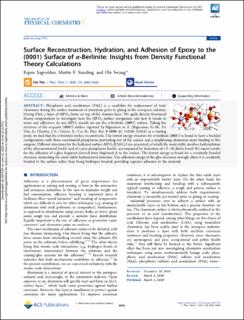| dc.contributor.author | Sagvolden, Espen | |
| dc.contributor.author | Sunding, Martin Fleissner | |
| dc.contributor.author | Swang, Ole | |
| dc.date.accessioned | 2020-10-27T07:00:55Z | |
| dc.date.available | 2020-10-27T07:00:55Z | |
| dc.date.created | 2020-03-31T20:42:36Z | |
| dc.date.issued | 2020 | |
| dc.identifier.citation | Journal of Physical Chemistry C. 2020, 124 (12), 6683-6688. | en_US |
| dc.identifier.issn | 1932-7447 | |
| dc.identifier.uri | https://hdl.handle.net/11250/2685109 | |
| dc.description.abstract | Phosphoric acid anodization (PAA) is a candidate for replacement of toxic chromates during the surface treatment of aluminum prior to gluing in the aerospace industry. During PAA, a layer of AlPO4 forms on top of the alumina layer. We apply density functional theory computations to investigate how the AlPO4 surface reorganizes and how it bonds to water and adhesives. As our AlPO4 model, we use the α-berlinite (0001) surface. Taking the structure of the α-quartz (0001) surface reported by Rignanese et al. (Rignanese, G.-M.; De Vita, A.; Charlier, J.-C.; Gonze, X.; Car, R., Phys. Rev. B 2000, 61, 13250−13255) as a starting point, we find that the α-berlinite surface reconstructs. The lowest energy structure for α-berlinite (0001) is found to have a buckled configuration, with three-coordinated phosphorus protruding out of the surface and a neighboring aluminum atom binding to five oxygens. Different structures for the hydrated surface AlPO4·0.25H2O are presented, of which the most stable involves hydroxylation of the aforementioned buckle and of a new phosphorus buckle, accompanied by formation of a P−Al dative bond. We report results for the adhesion of a glue fragment derived from bisphenol A to the surface. The lowest energy is found for a covalently bonded structure, mimicking the most stable hydroxylated structure. The adhesion energy of the glue increases strongly when it is covalently bonded to the surface rather than being hydrogen bonded, providing superior adhesion to the material. | en_US |
| dc.language.iso | eng | en_US |
| dc.publisher | ACS Publications | en_US |
| dc.rights | Navngivelse 4.0 Internasjonal | * |
| dc.rights.uri | http://creativecommons.org/licenses/by/4.0/deed.no | * |
| dc.subject | Aluminium | en_US |
| dc.subject | Surface | en_US |
| dc.subject | Structures | en_US |
| dc.title | Surface Reconstruction, Hydration, and Adhesion of Epoxy to the (0001) Surface of α-Berlinite: Insights from Density Functional Theory Calculations | en_US |
| dc.type | Peer reviewed | en_US |
| dc.type | Journal article | en_US |
| dc.description.version | publishedVersion | en_US |
| dc.rights.holder | © 2020 American Chemical Society | en_US |
| dc.subject.nsi | VDP::Fysikalsk kjemi: 443 | en_US |
| dc.subject.nsi | VDP::Physical chemistry: 443 | en_US |
| dc.source.pagenumber | 6683-6688 | en_US |
| dc.source.volume | 124 | en_US |
| dc.source.journal | Journal of Physical Chemistry C | en_US |
| dc.source.issue | 12 | en_US |
| dc.identifier.doi | 10.1021/acs.jpcc.9b11794 | |
| dc.identifier.cristin | 1804638 | |
| dc.relation.project | Notur/NorStore: NN2147K | en_US |
| dc.relation.project | Norges forskningsråd: NN9393k | en_US |
| dc.relation.project | Norges forskningsråd: 194068 | en_US |
| cristin.ispublished | true | |
| cristin.fulltext | original | |
| cristin.qualitycode | 1 | |

